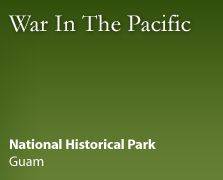| |
Fires are powerful drivers of ecological communities with the ability to cause changes in the abundance and presence of plant and animal species. While their destructive capabilities are well known, fire can also be critically important to some natural communities -- such as pine forests, giant Sequoia or grasslands -- where fire is critical to their survival. These ecosystems have evolved in the presence of fire, and the individual species have special adaptations that allow them to survive burning. In many cases, fire is so important that without it, these communities cannot survive.

On Guam, fire is not a part of the island’s natural environment. The island lacks natural ignition sources. Lightning is a rare event, and when the island does experience lightning, it is usually accompanied by heavy rain. Guam has no lava or other volcanic activity capable of starting wildfires. The island's relative humidity is high, usually above 80%, and these moist conditions are not conducive to starting fires from sparks, spontaneous ignition, or cigarettes. These sources require a lower relative humidity (generally less than about 25%) to have a realistic chance of setting most vegetation aflame.
People intentionally set almost all fires on Guam. Local hunters use fire to clear sightlines and draw deer and pigs into the open. Wildland arson is also common, especially along roadsides; it is not uncommon for an arsonist to start a series of fires along a one or two mile stretch of road. Farmers will sometimes illegally burn fields to clear them, and homeowners will burn savanna to create firebreaks around their residence. All of these activities are illegal (in some cases, burning can be conducted legally with a permit from the Guam Department of Agriculture). Wildland burning on federal lands, including in National Parks, is a felony offense.
Guam’s native plants and animals are poorly adapted to frequent burning. Young native trees are easily burned and have difficulty surviving without an overstory of adult trees to provide the environmental conditions required for their survival. Prior to the arrival of humans, Guam was heavily forested, and, grasslands, while present, were relatively rare. The introduction of fire to the island by people has caused Guam’s native forest to be replaced with grasslands, in which many of the species are non-native and well adapted to repeated burning.
On Guam, wildfires are particularly insidious, and once a biological community enters a cycle of repeated burning, it is difficult to break out of it. Grasslands, particularly ones with non-native fire-adapted grasses, promote more fire; dry grass is an excellent fuel source. Repeated burnings expand the spatial extent of grasslands by burning back the forest edge. Grasses quickly invade the burned ground and increase the size of the grassland. Fire is maintaining Guam's savannas, and without it, it is likely that forests would encroach upon and eventually replace grasslands.
The environmental impact of fire extends beyond the forests and grasslands. In fact, impacts from wildfires extend into the ocean and onto Guam's coral reefs. Fires remove vegetation, leaving bare ground that is susceptible to erosion when it rains. Research by National Park Service biologists has shown a five-fold increase in erosion rates on burned compared to unburned savanna. The eroding topsoil is transported to the ocean where it settles on corals, potentially killing them. Sediments are believed to be responsible for the coral die-off on southwestern Guam, and poor erosion control during road construction is the most likely cause of this mortality. Sedimentation has been identified by several international conservation agencies as one of Guam’s primary threats to its coral reefs.
Guam’s coral reefs are home to over 4,500 species, including a thousand species of fish, hundreds of species of coral and algae, giant clams, crabs, and endangered sea turtles. The reefs form the base of Guam’s tourist economy, are important to local residents for recreation and subsistence fishing, and provide shoreline protection during storms. The degradation and loss of Guam’s coral reefs will irreparably damage the quality of life to all of Guam’s people.
Soil erosion also damages the land. Plants need topsoil to grow, and Guam’s topsoil is thin, forming a layer about five inches thick in many places. This topsoil layer, which has taken tens of thousands of years to form, can be entirely lost with as few as 15-20 burn events. Once the topsoil has eroded, the underlying clays, which are alkaline and nutrient poor, cannot support vegetation, leading to “badland” areas, those patches of bare red dirt that are a common sight on southern Guam. Badlands are incapable of naturally re-vegetating and they will continue to erode and release sediments onto Guam’s nearshore coral reefs. Some preliminary work by park biologists has shown that badlands may be eroding at a rate that is ten times higher than surrounding grasslands.
Burning and War in the Pacific National Historical Park
Savanna grassland fires are serious problem in War in the Pacific NHP. Estimates s uggest that an average of 20% of the park’s land burns every year. While this appears to be an overestimate, hard data are lacking. Park biologists have begun a project to detect, map, and research wildfires in the park. As part of this project, the Natural Resources Division at War in the Pacific NHP is currently investigating the effects of fire on upland erosion rates and on savanna vegetation. They hope to obtain baseline data on erosion rates associated with the park’s extensive savanna grasslands and to estimate the amount of soil erosion occurring within the park. In order to do this, park biologists have undertaken a multi-part project to: uggest that an average of 20% of the park’s land burns every year. While this appears to be an overestimate, hard data are lacking. Park biologists have begun a project to detect, map, and research wildfires in the park. As part of this project, the Natural Resources Division at War in the Pacific NHP is currently investigating the effects of fire on upland erosion rates and on savanna vegetation. They hope to obtain baseline data on erosion rates associated with the park’s extensive savanna grasslands and to estimate the amount of soil erosion occurring within the park. In order to do this, park biologists have undertaken a multi-part project to:
- Identify and mapping park savanna grasslands into GIS.
- Determine natural erosion rates in three savanna grassland vegetation types: diverse, swordgrass-dominated, and fern-dominated grasslands.
- Compare natural grassland erosion rates to badlands.
- Estimate erosion rates in burned and unburned savannas.
- Describe savanna vegetation, including the species composition and distribution, in each of the grassland vegetation types.
- Study erosion rates through time and document vegetation changes associated with burning.
This work, started in the summer of 2003 is expected to continue into 2005 and is being conducted in conjunction with coral reef sedimentation research. These projects will provide the park with a watershed level assessment of its natural resources and the severity of fire and erosion as a detrimental impact. This information will used to develop a series of best management practices to reduce the destructive effects of wildfire on the park's environment.
This research is being conducted with the assistance of many partners, including the University of Guam, Guam Division of Forestry, Guam Division of Aquatic and Wildlife Resources, and Micronesian Divers Association. Funding for this project has come from the National Fish and Wildlife Foundation and the National Park Service.
Dwayne Minton, Ph.D
|
|





